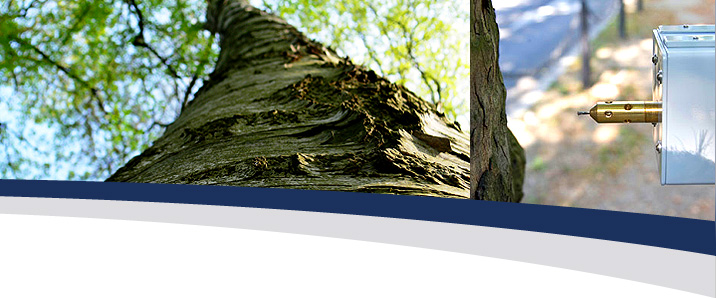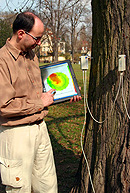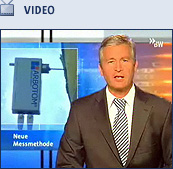Tree diagnosis |
Assessment of traffic safety
The RINNTECH conceptAny tree examination initially requires a detailed visual inspection of the tree including its root, trunk/stem, crown and location. If the visual inspection and diagnosis of the tree is not sufficient to judge the traffic safety of trees or to provide objective evidence of findings, we use the following technical methods, depending on the requirements of the individual case:
Using these methods, we can determine the inner status of trees and draw conclusions as to their breakage safety and their stability. They are often applied in various steps. Recording the vitality, growth, and damagesThe tree ring structure often provides the answer to the question as to what has damaged or killed a tree, and who is responsible. The RINNTECH conceptAfter a visual inspection of the tree status, we perform anatomic investigations and tree ring analyses using LINTAB™ and TSAP-Win™. Pointer years and sudden changes in growth trends are clear indications of external stress factors. In many cases, only an increment analysis can tell whether or not a tree still is sufficiently vital, and whether it still makes sense to invest money into arboricultural care. |

For more information, please refer to the following documentations.




 Protecting people from trees, or protecting trees from people? This is the question tree experts and the relevant authorities are often confronted with. The decisions to make are often difficult. The most frequent urban stress factors suffered by trees are damages resulting from road works, car accidents, soil compaction, vibration, air pollution, de-icing salt, etc. They result in damages at and to trees, such as frequent rotting or instability, which threaten not only their own survival but may also become dangerous for people.
Protecting people from trees, or protecting trees from people? This is the question tree experts and the relevant authorities are often confronted with. The decisions to make are often difficult. The most frequent urban stress factors suffered by trees are damages resulting from road works, car accidents, soil compaction, vibration, air pollution, de-icing salt, etc. They result in damages at and to trees, such as frequent rotting or instability, which threaten not only their own survival but may also become dangerous for people.
